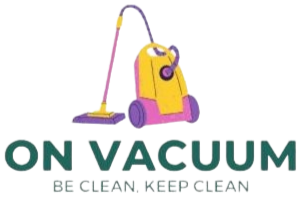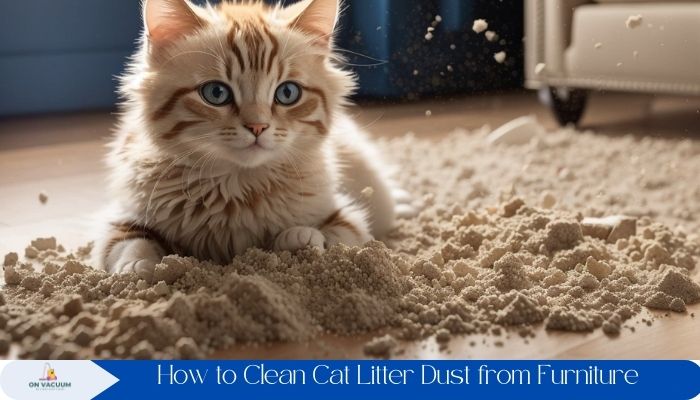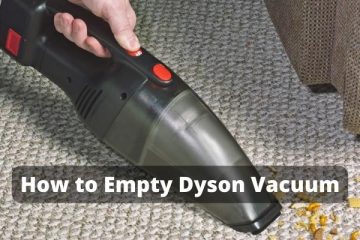Uncover expert tips on how to clean cat litter dust from furniture! Preserve the charm of your living space with easy and effective cleaning hacks.
Understanding Cat Litter Dust
Cat owners understand that dealing with cat litter dust is inevitable in living with a feline friend. But what exactly is this substance, and why does it seem on every surface?
What is Cat Litter Dust?
Cat litter dust is a byproduct of the manufacturing process of clay-based litters. It consists of fine particles that can become airborne when disturbed, causing potential respiratory issues for both pets and humans and settling on furniture surfaces around the house.
Why Does Cat Litter Dust Stick to Furniture?
The fine nature of cat litter dust makes it particularly adhesive. This dust clings to furniture due to static electricity. Removing it can be challenging, often requiring more than a simple dusting to fully eradicate.
How to Clean Cat Litter Dust from Furniture
Pre-Cleaning Strategies
Before diving into cleaning, it’s essential to arm yourself with the right tools and prepare the furniture adequately.
Selecting the Right Cleaning Tools
Choosing the correct cleaning tools is the first step in battling cat litter dust. A vacuum cleaner with a high-efficiency particulate air (HEPA) filter and microfiber cloths can significantly enhance the cleaning process.
Preparing the Furniture for Cleaning
Preparing the furniture involves removing any loose dust and debris before starting the deep cleaning process. A quick vacuum or wipe-down can make the subsequent cleaning steps more effective.
Effective Cleaning Techniques
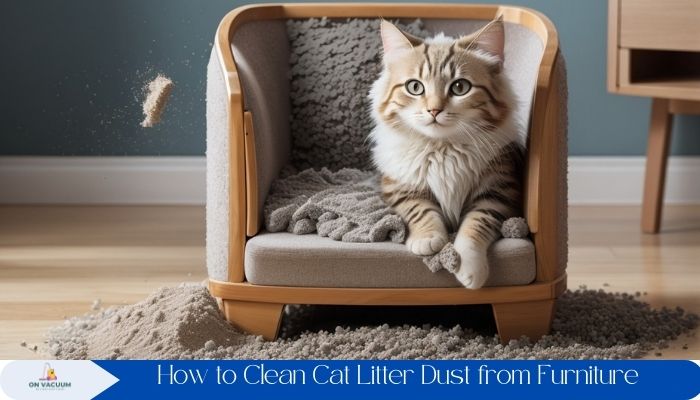
Once the pre-cleaning phase is complete, it’s time to dive into more thorough methods to ensure your furniture is free of cat litter dust.
Utilizing Vacuum Cleaners for Optimal Results
Vacuum cleaners equipped with HEPA filters are ideal for removing cat litter dust as they can trap the finest particles. Regular vacuuming can significantly reduce the dust levels on your furniture and home.
Employing Microfiber Cloths and Cleaning Solutions
Due to their dense fibres, microfiber cloths can trap and remove more dust than regular cloths. They can effectively remove sticky dust from furniture surfaces when paired with a suitable cleaning solution.
Preventive Measures for a Dust-Free Environment
Prevention is always better than cure. Adopting certain measures can help minimize the amount of cat litter dust in your environment.
Choosing Low-Dust Cat Litter
Opting for low-dust or dust-free cat litter can significantly reduce the airborne dust generated when your cat uses the litter box. These litters are often made from materials like recycled paper or wood, making them a more eco-friendly option.
Regular Cleaning and Maintenance Tips
Regular cleaning of the litter box and the surrounding area can help control dust levels. Additionally, maintaining proper ventilation in the room containing the litter box can aid in dispersing airborne dust.
Addressing Common Challenges
Sometimes, despite our best efforts, challenges arise. Persistent dust and ensuring the safety of pets and children during cleaning are common concerns for cat owners.
Dealing with Persistent Dust and Stains
For persistent dust and stains, a deep cleaning approach may be necessary. Consider using a mixture of water and white vinegar, a natural cleaning agent, to tackle stubborn residues.
Safe Cleaning Around Pets and Children
Always ensure that any cleaning agents used are pet and child-safe. Natural cleaners like baking soda and vinegar are usually safe alternatives to chemical-based products.
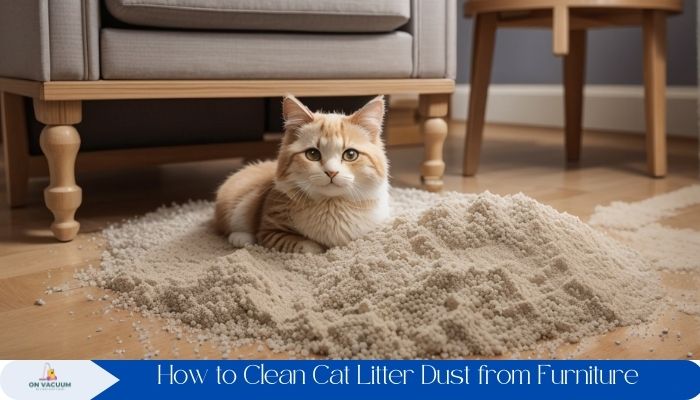
Additional Tips and Tricks
Additional tips and tricks always make the cleaning process easier and more effective.
DIY Cleaning Solutions
Homemade cleaning solutions, such as a mixture of water and vinegar or lemon juice, can be effective and safe alternatives for cleaning furniture surfaces affected by cat litter dust.
Furniture Material Considerations
Different furniture materials may require different cleaning approaches. Always test any cleaning solution on a small, inconspicuous area first to ensure it won’t damage the furniture.
Expert Advice on Deep Cleaning
When it comes to dealing with persistent cat litter dust, sometimes regular cleaning methods just don’t cut it. Deep cleaning becomes essential in maintaining not only your furniture’s aesthetics but also your living environment’s health.
When to Seek Professional Cleaning Services
There’s cleaning, and then there’s deep cleaning. But when should one consider calling in the pros? When regular cleaning routines don’t seem to reduce dust levels or when dealing with delicate or antique furniture, seeking professional cleaning services can be a game-changer. Experts can address stubborn stains and dust, ensuring the longevity and cleanliness of your furniture.
Protecting Furniture During Deep Cleaning
Protecting your furniture during deep cleaning is paramount. Remove any delicate or breakable items from the furniture and cover areas not being cleaned with protective sheets. Utilizing furniture protectors or covers can also prevent potential damage from cleaning agents.
Read more about How to Clean Cat Litter Dust from Walls
Frequently Asked Questions
Let’s address some common queries when dealing with cat litter dust on furniture.
Can I Use Furniture Polish After Cleaning?
Using furniture polish after cleaning can help restore the shine and protect the surface. However, ensure that the furniture is completely dry and free of cleaning residues before application. Always follow the manufacturer’s instructions on the polish to avoid any damage to the furniture.
How Often Should I Clean Furniture from Cat Litter Dust?
Frequent cleaning is essential to manage cat litter dust. A weekly cleaning routine can help maintain a dust-free environment. Still, depending on the dust level and furniture type, more frequent cleaning might be necessary.
Real-life Scenarios and Solutions
Every household is unique, and addressing the challenges posed by cat litter dust may require tailored approaches.
Addressing Unique Furniture Types
Different furniture materials require different cleaning techniques. Leather furniture, for example, might need a gentle cleaner and conditioner. In contrast, wooden furniture might benefit from a mild soapy solution and polish. Always follow the care instructions provided for the specific furniture material.
Managing Cat Behavior to Reduce Dust
Managing your cat’s behaviour can significantly reduce the amount of litter dust. Training your cat to use the litter box correctly and placing mats around the box to trap dust can be effective strategies. Additionally, providing your cat with alternatives like scratching posts can help reduce dust spread.
Concluding Thoughts
Maintaining a home with cats can be challenging. Still, it is possible to manage cat litter dust effectively with the right strategies and knowledge.
Maintaining a Clean and Healthy Living Space
Cat owners can enjoy a harmonious living space by adopting regular cleaning routines, considering professional cleaning services when needed, and addressing unique challenges. The goal is to balance the joy of having a cat while maintaining a clean and healthy environment.
Conclusion
Cats bring joy and companionship, but they also bring cat litter dust. Armed with expert advice, real-life solutions, and a proactive approach, managing and cleaning this dust becomes manageable. Keep exploring, learning, and adapting your strategies for a clean, harmonious home with your feline friend.
FAQs
Can deep cleaning damage my furniture?
With proper precautions and following the furniture’s care instructions, the risk of damage during deep cleaning is minimal.
How often should professional cleaning services be sought?
The frequency depends on the dust issue’s severity and the furniture type. However, seeking professional help annually or bi-annually can be beneficial.
Can managing cat behaviour effectively reduce dust?
Yes, training your cat and providing alternatives like scratching posts can significantly reduce the spread of dust.
Are there specific cleaning products for different furniture types?
Yes, different furniture materials require specialized cleaning products. Always use products recommended for the specific material to avoid damage.
Where can I find further resources on maintaining a clean and healthy living space with a cat?
Vet clinics, professional cleaning services, and online forums are excellent sources of information. Additionally, various online platforms offer resources and products to aid in
Why does cat litter dust stick to furniture?
Cat litter dust sticks to furniture due to its fine nature and static electricity, making removing it challenging.
What cleaning tools are effective against cat litter dust?
Vacuum cleaners with HEPA filters and microfiber cloths are particularly effective against cat litter dust.
How can I prevent cat litter dust?
Choosing low-dust or dust-free cat litter and regular cleaning and maintenance of the litter box area can help prevent cat litter dust.
Are DIY cleaning solutions safe for pets and children?
DIY cleaning solutions like water, vinegar, or lemon juice are typically safe for pets and children. Still, it’s always best to ensure any cleaning agents used are non-toxic.
Do different furniture materials require different cleaning methods?
Yes, different furniture materials may require different cleaning approaches. Always test any cleaning solution on a small, inconspicuous area first.
